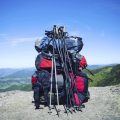1. Choosing the Right Wilderness Area
Picking the perfect wilderness spot for your solo backpacking trip in America is a big deal. With so many incredible options, it’s important to consider your experience level, the type of landscape you want to explore, and the logistics involved. Here’s how to make the best choice for your adventure:
Know Your Terrain
The U.S. is home to a huge variety of landscapes—from rugged mountains and thick forests to desert canyons and wild coastlines. Ask yourself what kind of scenery excites you most and what you feel comfortable tackling on your own.
| Terrain Type | Best For | Popular Locations |
|---|---|---|
| Mountains | Experienced hikers, cooler temps, panoramic views | Sierra Nevada, Rockies, White Mountains |
| Forests | All skill levels, wildlife viewing, shaded trails | Appalachian Trail, Pacific Northwest, Ozarks |
| Deserts | Winter trips, stargazing, solitude seekers | Grand Canyon, Joshua Tree, Utah’s Red Rock country |
| Coastal Areas | Mild weather, ocean views, unique flora and fauna | Olympic National Park, Big Sur, Cape Cod National Seashore |
Accessibility Matters
Some wilderness areas are just a short drive from major cities, while others require long drives or even flights to reach. Think about how far you’re willing to travel and whether you’ll need special transportation (like ferries or 4WD vehicles). Make sure trailheads are accessible year-round—some close in winter due to snow or mud.
Weather Considerations
The time of year can make or break your trip. High mountain passes might be snowed in until July; deserts can be dangerously hot in summer. Always check average temperatures and precipitation for the region during your planned travel dates.
Quick Weather Tips:
- Summer: Northern states and high elevations are cooler.
- Fall: Great for leaf-peeping in the East and fewer bugs out West.
- Spring: Watch out for muddy trails as snow melts.
- Winter: Head south or stick to lower elevations unless you have winter skills.
Permits & Regulations on U.S. Public Lands
A lot of America’s wildest places are managed by different federal or state agencies—each with its own rules. Many popular wilderness areas require permits for overnight stays (especially in national parks) that may need to be reserved months in advance.
| Lands Agency | Main Regulations/Permits Needed | Where to Check Info |
|---|---|---|
| NPS (National Park Service) | Backcountry permits often required; strict group size limits; bear canisters may be mandatory. | NPS.gov (individual park pages) |
| Bureau of Land Management (BLM) | Usually more flexible; some areas have permit lotteries (e.g., The Wave). | Bureau of Land Management website or local field offices |
| U.S. Forest Service (USFS) | Wilderness permits needed for some areas; campfire restrictions common. | USDA Forest Service website or ranger stations |
| State Parks/Forests | Differ by state; may require parking passes or campsite reservations. | Your state parks department website |
TIPS:
- If you’re new to solo backpacking, start with well-traveled areas where help is close at hand.
- If seeking solitude, look for lesser-known wildernesses—but always tell someone your route!
Your Next Step:
Narrow down a few destination options that match your skill level and interests. Next up: getting ready for solo safety and navigation!
2. Essential Gear for Solo Backpackers
Heading out solo into America’s wilderness is a thrilling adventure, but having the right gear can make or break your trip. From the dense forests of the Pacific Northwest to the arid deserts of the Southwest, the U.S. backcountry presents a wide range of challenges. Here’s what you’ll need to stay safe, comfortable, and prepared for whatever nature throws your way.
Must-Have Gear for Different U.S. Environments
| Environment | Key Gear Items | Why It Matters |
|---|---|---|
| Mountainous (Rockies, Sierra Nevada) | Four-season tent, layered clothing, microspikes | Unpredictable weather and cold nights require proper shelter and insulation |
| Desert (Southwest, Mojave) | Sun hat, UV-protective clothing, extra water containers | Protection from sun and staying hydrated are top priorities |
| Forest (Appalachians, Pacific Northwest) | Rain gear, insect repellent, bear canister | Frequent rain and wildlife encounters demand special precautions |
| Tundra/Alpine (Alaska, high elevations) | Cold-weather sleeping bag, satellite communicator, windproof layers | Extreme cold and isolation require advanced safety and warmth solutions |
Packing Ultralight: What You Really Need
Ultralight backpacking is popular among solo hikers in the U.S., allowing you to cover more miles with less strain on your body. Focus on multipurpose gear and cut down to essentials:
- Tent or Shelter: Consider a lightweight tarp or bivy sack for mild climates.
- Sleeping System: Down quilts pack small and weigh less than traditional sleeping bags.
- Cooking Gear: A compact stove like a Jetboil or even a cold-soak jar for no-cook meals.
- Water Filtration: Squeeze filters or chemical tablets save weight and space.
- Packing Tip: Keep your base weight (gear minus food/water) under 15 lbs if possible.
Bear Safety: Musts for American Backcountry Trails
If you’re hiking anywhere in bear country—think Yellowstone or the High Sierra—protecting yourself and your food is critical. Most U.S. parks require approved bear canisters or bear bags:
- Bear Canister: Hard-sided container that stores all scented items; required in many national parks.
- Bears Bags (e.g., Ursack): Lightweight and resistant to bear claws when hung properly.
- Bears Spray: Non-lethal deterrent; keep it easily accessible at all times.
- Campsite Setup: Cook and store food at least 100 yards from your tent.
Navigation Tools Used by U.S. Hikers
The vastness of American wilderness means cell service is often unreliable. Here are navigation tools commonly used by experienced solo backpackers:
- Paper Maps & Compass: Always carry these as backups; learn basic navigation skills before heading out.
- GPS Devices: Units like Garmin inReach offer GPS tracking plus emergency SOS features.
- Trekking Apps: Download offline maps via apps like Gaia GPS or AllTrails before your trip.
- SAT Communicators: Satellite messengers allow check-ins with family and emergency contacts from remote areas.
![]()
3. Safety and Self-Reliance
Staying Safe in the Wild: Core Guidelines
Solo backpacking across America’s wilderness is an unforgettable adventure, but it comes with unique risks. Being prepared and knowing how to handle emergencies will make your journey safer and more enjoyable. Here are some key guidelines that experienced American outdoorspeople swear by:
Wildlife Encounters: What to Do
| Animal | Best Practices |
|---|---|
| Bears | Carry bear spray; make noise while hiking; store food in bear canisters or hang it from a tree; never approach or run from a bear. |
| Mountain Lions | Maintain eye contact; make yourself look larger; never turn your back or run; if attacked, fight back aggressively. |
| Snakes | Watch where you step and place your hands; avoid tall grass and rocks without checking first; wear boots and long pants. |
Medical Emergencies: Essential Steps
- Carry a First Aid Kit: Always pack a kit with bandages, antiseptic, tweezers, pain relievers, and any personal medications.
- Learn Basic Wilderness First Aid: Take a class if possible—many American hikers recommend the NOLS or Red Cross courses.
- Know How to Signal for Help: A whistle, mirror, or brightly colored cloth can attract attention. Consider carrying a Personal Locator Beacon (PLB) or satellite messenger for remote areas.
- Stay Calm and Assess: In case of injury, stay calm. Assess the situation before moving or making decisions.
Solo Safety Habits to Follow
- Tell Someone Your Plan: Share your route and expected return time with a friend or family member. Stick to your plan as much as possible.
- Check Weather Conditions: Use reliable sources like the National Weather Service before heading out. Be ready to adjust plans if storms threaten.
- Avoid Risky Shortcuts: Stick to marked trails whenever possible—getting lost is one of the top dangers for solo hikers in the U.S.
- Pace Yourself: Don’t push too hard. Fatigue increases your chances of injury and makes decision-making harder.
Packing Checklist for Self-Reliance
| Must-Have Gear | Why It Matters |
|---|---|
| Map & Compass/GPS | Navigational tools are crucial in unfamiliar terrain—don’t rely solely on cell service. |
| Multi-tool/Knife | Helps with repairs, food prep, and emergencies. |
| Bivy Sack/Emergency Blanket | Keeps you warm if you have to spend an unplanned night outdoors. |
| Extra Food & Water Purification System | Sustain energy and stay hydrated even if delayed or off-trail longer than planned. |
| Lighter/Waterproof Matches & Firestarter | A fire can be essential for warmth and signaling for help. |
| Pepper Spray/Bear Spray (where legal) | An added layer of protection against wildlife threats. |
The best way to enjoy America’s great outdoors alone is by being smart, prepared, and always prioritizing safety. With these tips and habits, you’ll be ready to tackle whatever nature throws your way!
4. Leave No Trace and Wilderness Ethics
When you’re solo backpacking in America’s wilderness areas, it’s important to remember that you’re not just a visitor — you’re a caretaker. The U.S. is home to stunning public lands, from national parks to remote forests, and every backpacker plays a role in preserving them for future generations. That’s where the Leave No Trace (LNT) principles come in. These guidelines are widely respected across the country and help minimize your impact on nature.
What is Leave No Trace?
Leave No Trace is a set of seven core principles designed to guide outdoor enthusiasts in making responsible decisions when exploring wild places. Following LNT isn’t just about rules — it’s about respect for the land, wildlife, and other people who come after you.
The 7 Leave No Trace Principles
| Principle | What It Means for Solo Backpackers |
|---|---|
| Plan Ahead and Prepare | Know your route, check regulations, pack proper gear, and be ready for emergencies so you can avoid risky shortcuts or mistakes that could harm the environment. |
| Travel and Camp on Durable Surfaces | Stick to established trails and campsites. If you must go off-trail, choose rock, gravel, dry grass, or snow instead of delicate plants or soils. |
| Dispose of Waste Properly | “Pack it in, pack it out.” Bring all trash back with you, including food scraps. Use bathrooms where available or follow local guidelines for burying waste. |
| Leave What You Find | Don’t pick flowers, remove rocks, or carve on trees. Keep wilderness areas as wild as you found them for others to enjoy. |
| Minimize Campfire Impact | If fires are allowed, use existing fire rings and keep fires small. Better yet, use a camp stove to cook your meals. |
| Respect Wildlife | Observe animals from a distance. Never feed wildlife and store your food securely so animals don’t get used to human snacks. |
| Be Considerate of Other Visitors | Keep noise down and yield the trail when needed. Solo backpackers often find solitude—help preserve that peace for others too. |
Wilderness Ethics: Beyond the Basics
In addition to LNT principles, practicing good wilderness ethics means understanding your responsibility as a solo traveler. This includes:
- Respecting Local Regulations: Different areas may have specific rules (like bear canister requirements or campfire bans). Always check before you go.
- Cultural Sensitivity: Many wilderness areas are sacred to Indigenous peoples. Be mindful of cultural sites and avoid disturbing artifacts or marked locations.
- Helping Others: While hiking alone, if you encounter someone in need, offer assistance if it’s safe to do so — its part of the American backcountry spirit.
Your Impact Matters!
No matter how experienced you are or how remote your adventure gets, following Leave No Trace and strong wilderness ethics makes sure America’s wild places stay healthy and beautiful for everyone who seeks adventure there.
5. Planning Your Trip and Connecting With the Outdoor Community
Map Out Your Route
Before you hit the trail, spend time researching your route. Use detailed topographic maps and apps like Gaia GPS or AllTrails to plan each day’s mileage, elevation gain, water sources, and potential campsites. Always have a paper map and compass as backup, even if you rely on a smartphone or GPS device.
Sample Route Planning Table
| Day | Start Point | End Point | Miles | Main Landmarks | Water Sources |
|---|---|---|---|---|---|
| 1 | Trailhead A | Campsite 1 | 8 | Pine Lake, Vista Ridge | Pine Creek (mile 6) |
| 2 | Campsite 1 | Campsite 2 | 10 | Boulder Pass, Eagle Overlook | Stream (mile 4), Spring (mile 9) |
| 3 | Campsite 2 | Trailhead B | 7 | Bass Meadow, Old Fire Tower | Bass Meadow Pond (mile 3) |
Understand Permit Regulations and Wilderness Rules
Wilderness areas in the US often require permits for overnight trips, especially in popular spots like Yosemite or Glacier National Park. Check the official website of the forest service or park for up-to-date info. Some permits are available online months in advance; others are first-come, first-served at ranger stations.
Common Permit Resources:
- Recreation.gov
- National Park Service (NPS) official sites for specific parks/wilderness areas
- Local ranger stations and visitor centers for walk-in permits and updates on trail conditions
Tapping Into Local Resources & Networks
Ranger Stations and Visitor Centers
Before heading out, stop by local ranger stations or visitor centers. Rangers know current trail conditions, water availability, fire restrictions, wildlife activity, and can suggest alternate routes if needed. They’re also a great resource for up-to-date weather forecasts and emergency contacts.
Connect With Local Outfitters & Gear Shops
Many towns near wilderness areas have outdoor shops where you can pick up last-minute gear, fuel canisters, or even rent equipment. Staff often have insider knowledge about recent trail closures or hazards and may offer shuttle services to trailheads.
Join Online Forums Popular Among American Backpackers:
| Name of Forum/Group | Description & Link |
|---|---|
| The Trek Forums & Articles | A go-to resource for solo backpackers on long-distance trails like the Appalachian Trail or Pacific Crest Trail. thetrek.co/forums/ |
| Reddit r/Ultralight & r/CampingandHiking | Lively communities sharing trip reports, gear tips, and safety advice. reddit.com/r/Ultralight/ |
| Backpacker Forums | A classic message board with region-specific threads for routes and meet-ups.backpacker.com/forums/ |
| Facebook Groups (e.g., Solo Backpacking USA) | Easily connect with others planning similar trips or looking for advice. |
| Meetup.com Outdoor Groups | If you want to meet up with locals before or after your solo trip. |
Packing Tip: Double-Check Everything!
Create a checklist based on your planned route and consult forums for gear recommendations that match local conditions—what works in Utah’s deserts won’t be right for Washington’s rainforests! Reach out to local backpackers online if you’re unsure about anything—Americans love sharing their favorite trail tips.
Your Checklist Might Include:
- Dinner reservations at a post-trail burger joint (seriously!)—ask locals for their favorites.
- A note of local emergency numbers saved in your phone.
- A quick hello at the ranger station before heading out so they know your plans.
- Your permit printed out or saved offline on your phone.
- A backup exit plan if the weather turns bad.
The more effort you put into planning—and connecting with the outdoor community—the smoother (and safer) your solo adventure will be!


